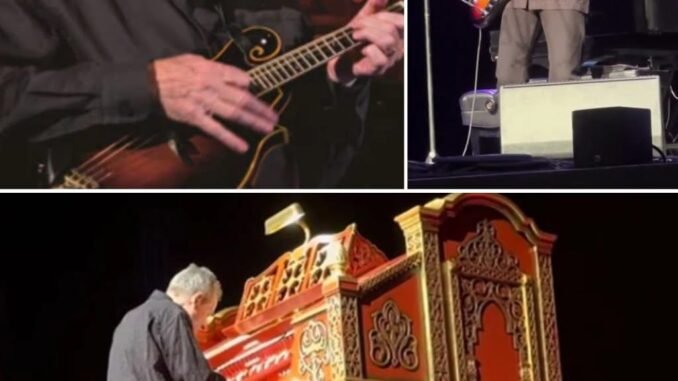
John Paul Jones Just Turned Back Time in Knoxville: A Stunning Night at Big Ears Festival
There are concerts that entertain—and then there are concerts that transcend. At the 2025 Big Ears Festival in Knoxville, Tennessee, John Paul Jones delivered the latter. In a performance that felt both timeless and deeply personal, the legendary multi-instrumentalist and founding member of Led Zeppelin gave fans more than just a night of music. He gave them a journey through the very fabric of rock history.
From the moment Jones stepped onstage, there was an energy in the room — a hush of reverence mixed with electricity. This wasn’t a spectacle or an over-the-top reunion gig. There were no lasers, no pyrotechnics, no massive screens. It was just Jones, a handful of instruments, and a capacity crowd hanging on every note. And that was all it took.
He began on the pipe organ, filling the cathedral-like venue with a swelling, cinematic sound. The notes floated through the space like incense—thick, sacred, and stirring. Then, seamlessly, he transitioned to piano, fingers gliding with ease across the keys as he pulled listeners into a mood of introspection and memory. Not long after, he moved to the lap steel guitar, conjuring a sound that was mournful one moment and searing the next. And of course, he didn’t leave out the mandolin — an instrument he helped elevate to rock immortality on tracks like “Going to California.”
Watching Jones move from instrument to instrument with effortless mastery was a reminder of just how vast his musical vocabulary is. It’s one thing to be a brilliant bassist. It’s another to be a composer, arranger, and virtuoso who can seemingly make any instrument speak. He wasn’t showing off — he was simply communing with the music.
Then came the songs.
When he struck the first chords of “Your Time Is Gonna Come,” the audience collectively inhaled. The 1969 track, originally played on a Hammond organ on Led Zeppelin’s debut album, took on a whole new dimension live. Jones didn’t merely recreate it — he reimagined it. Slower, more meditative, but still brimming with purpose. It felt like a hymn, a benediction from one of rock’s high priests.
“No Quarter” followed — dark, mysterious, and utterly spellbinding. Long considered Jones’ signature Zeppelin moment, the song unfolded like a mist rolling across a battlefield. The piano lines twisted and turned, and you could feel the entire room hanging on every bar. He didn’t need a full band or Robert Plant’s wail to summon the song’s power. On his own, Jones mined a different kind of intensity — colder, sharper, more introspective. It was less a performance and more a spell.
And then came “Going to California.” With the mandolin resting comfortably in his hands, Jones plucked the opening notes and brought the house to silence. It was tender and aching, as if time itself had paused to listen. There were tears in the crowd — and no wonder. For many, this was the closest they’d ever come to hearing these songs live, performed by one of the men who helped write them.
Throughout the night, Jones barely spoke, but he didn’t need to. His instruments did all the talking — whispering, shouting, mourning, and rejoicing in equal measure. And while his presence was humble, there was no mistaking his command. Every transition was smooth, every note purposeful. It was a masterclass in control and restraint, in emotion and execution.
What made the evening so unforgettable wasn’t just the music itself—it was the intimacy. This wasn’t a stadium or an arena. It was a shared space, a sacred gathering where past and present met under soft lighting and shared breath. For longtime Zeppelin fans, it was something they thought they’d never get again: not just the sound of the songs, but the soul of them.
John Paul Jones reminded everyone that he was never just the quiet one in Led Zeppelin. He was the architect behind much of its most beautiful, complex work. The string arrangements. The keyboard layers. The sonic experiments that turned rock music into something more expansive and cinematic. And here in Knoxville, stripped of bombast, he showed that he hasn’t lost a single step.
The crowd’s response said it all. Not frenzied, but reverent. Not wild, but deeply moved. As the final notes rang out and Jones took his quiet bow, the standing ovation felt more like a thank you than a cheer. A thank you for the music, for the memories, and for the reminder that legends don’t fade—they evolve.
In the end, John Paul Jones didn’t just perform at Big Ears. He turned it into a moment of living history, one that won’t soon be forgotten. He brought us back to the golden age of rock and, somehow, pushed it forward at the same time.
Because that’s what true artists do. They don’t just play the songs. They breathe life into them, again and again — and in Knoxville, John Paul Jones proved once more that he’s not just a part of Led Zeppelin’s legacy.
Leave a Reply